“The World Cup should also be an opportunity for us to demonstrate the high standard of our information technology to the world. In this way, it will be remembered as an e-World Cup.”
– from one of Kim Dae-jung’s recent speeches
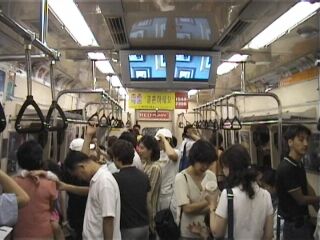
The World Cup matches are screened in the subway trains
Since we’re here running a multimedia weblog, I thought I’d take the opportunity to see what was going on in the digital world here in Korea. This is a report of my discoveries so far.
Kim Dae-jung wasn’t kidding. Korea has made huge efforts to make this World Cup the most technically proficient to date. In the process, Korea itself is being networked like no other country I have seen. Mobile phones work in the subway system, the games are shown live on monitors in the trains, half the population have broadband access (for US$18 per month – read this in England and weep), and the cabbies look like cyborgs plugged in to GPS systems, mobile phone conferencing and translation services. And that’s just for starters…
Everyday Life
Everyone in Korea, except the very young and the very old, has a mobile phone. The phone that we rented has a connection speed three times faster than a dial-up modem, it has a colour screen with animations and games, free email and web-browsing facilities, as well as live World Cup updates and an accommodation-finding service. However, in the manner of all great-looking tech, it works to a point – in this case, it sadly won’t receive SMS messages from my mum in the UK.
The internet cafes have blazingly quick T1 connections. As an example of how fast they are, I downloaded the entire Quicktime package in under ten seconds. That’s more than a megabyte per second – and I was using a line shared between a cafe that was full of people playing network games and browsing the web. Playing games for about a dollar an hour seems to be a very popular pastime for Korean youth – I guess the cafes are subsidised to get them in, in the hope they will learn more useful technical stuff by osmosis.
Prototyping Community Networking
In Hwang-Dun village, about 200km north-east of Seoul, I was shown around a model of how the Korean government and businesses see the networking technologies working in rural areas. Hwang-Dun is one of twenty villages which has been selected for “cyber-village” status, involving considerable inward investment of IT and training to see in what ways the villagers could benefit from internet technologies.
Down on the Cucumber Farm
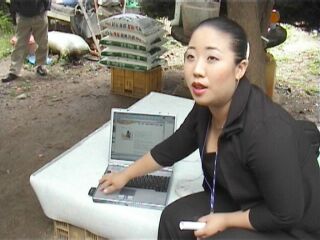
Wireless networking down on the farm
ADSL only works within about 3-4km of the local telephone exchange. For remotely located farmsteads which lie beyond this limit, the project had installed an 802.1x wireless network called Nespot. This is the same technology that Apple uses in its Airport range of wireless networking products, with the difference that Nespot provides access to all network services, including the internet, rather than just allowing one to wander about the house with a wireless laptop.
For the cucumber and tomato farmer whose laptop is pictured above, this meant that he could conduct a significant part of his business by email and via his website. He had to travel far less into town to sell his products since customers could order from him directly, and he was able to cut out a middleman in the process… helping his profit margins.
Steam Bun Bakery

Making steam buns
In the village itself, I found the same web-enabled business practices being adopted by a steam bun bakery. The village was chosen for the prototype scheme in part because it is famous throughout Korea for these delicious sweet red bean filled buns.

The buns are still made by hand
The bakery still makes its product in the traditional way, but the way it does its business has been almost completely revolutionised by the scheme. Sitting right next to the women rolling the buns and bean paste together in the bakery is a computer – from which the staff run their website, checking customers orders as they are placed through their website, and confirming deliveries for the following day.
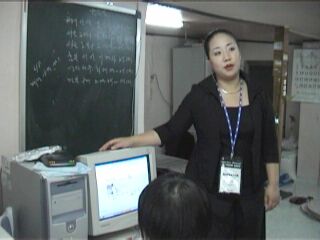
The bakery computer
The buns are delivered nationwide, and seem to be in high demand. The bakery claims that its turnover has doubled since the introduction of the website. I was impressed by the level of support that was given to these small businesses to allow them to get their e-business off the ground. Without intensive training and a lot of technical help, I doubt that they would have been able to make the conversion to these working practices.

The steam buns disappear like hot cakes
The local businesses were obviously benefitting from the technology, but I wondered what was in it for the corporations that had spent such a lot of money on the project. the usual options ran through my mind – publicity, goodwill, research and development of appropriate software, but then another thought occurred to me.
Korean cities are overcrowded in the extreme, and fewer and fewer people stay in the countryside. My best guess is that the government are keen to find ways to persuade people to remain in rural areas, in order to ease the population pressure on the cities. By installing networking technologies, they are able to show people that they will be able to access much the same kinds of services enjoyed by urban dwellers, and that they will in future be able to communicate more easily with their friends and families in other remote locations.
Prototype Products
Back in Seoul, KT, who organised the tour to the village, showed off the kinds of new communications devices that are just around the corner for the Korean people – and by extension, for the rest of the world…
Video Phones
Once touted as the killer app of the telephony world, and featured in just about every sci-fi flick since the dawn of cinema, video-phones are here already…
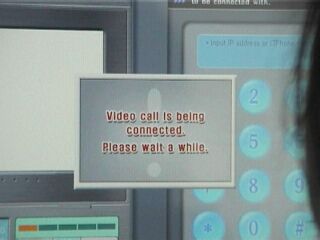
Connecting…
The Korean multimedia phone network is gradually spreading across Seoul (see this previous article) and yet it seems not to be popular, except amongst marketing folk and boffin-types. I stood for an hour watching the public phones, and not once did someone actually make a video call. Here in the demo room, however, KT were keen to show that they did in fact work.
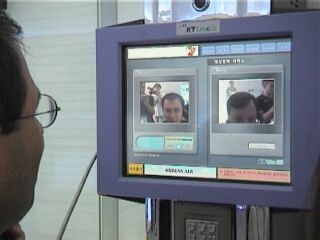
The call in progress
These phones were evidently made for Koreans, since the two Portuguese guys using it had the tops of their heads cut off for most of the time as the cameras pointed further down to the height of the average Korean (ironically, the photo above shows the opposite phenomenon) I’m still not sure of the benefits of being seen during a call… anyone care to persuade me it’s a good thing?
Portable WMP
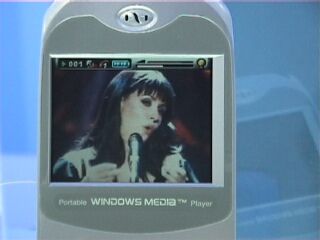
Portable Windows Media Player
For those of you who can’t live without your videos – here’s a prototype mobile WMP running MPEG4. The proprietary Microsoft MPEG4, that is – which conforms to few of the actual MPEG standards. Get product lock-in if you wish… I’ll be avoiding this one myself.
Code Square Phones
Now this one I like a lot… it’s a phone with a little camera in the hinge which faces outwards. It is designed to read colour squares which can be displayed anywhere. They are unique identifiers (a bit like a web address) and by pointing the phone at the little squares you can receive information in text form, as pictures or even video.
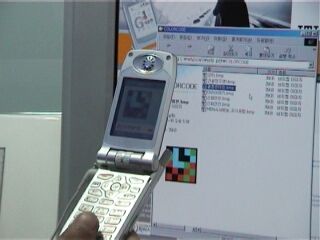
Code squares can be on websites
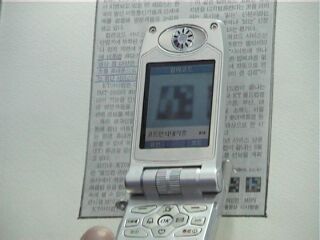
Code squares can be on paper
When your phone has registered the colour square, it automatically downloads whatever content it is that the colour square refers to, be it a video (as in the example in the image below), website, image, phone number or any required information.
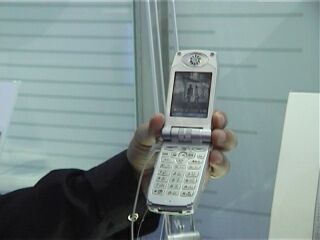
The phone shows the associated video.
Cool as…
Mobile Video Phones
In the same way that I am yet to be persuaded by ordinary videophones, I still remain uncertain of the benefits of adding pictures to a mobile phone call. The image just seems like redundant information – and may even, in some cases, be a disadvantage to the user. I’m thinking of the disabled, the disfigured and the hung-over for starters, let alone delving into race and gender issues.
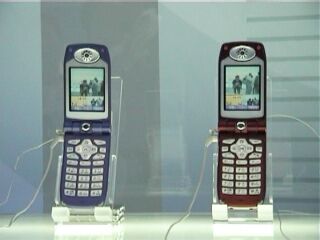
A pair of mobile videophones…
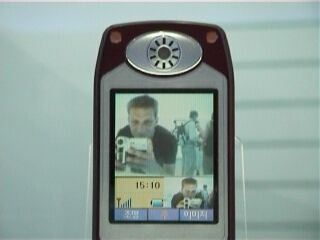
Or an expensive mirror?
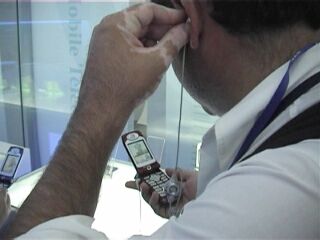
But the technology works, at least.
Mobile Phone Digicam
I quite liked this one too:
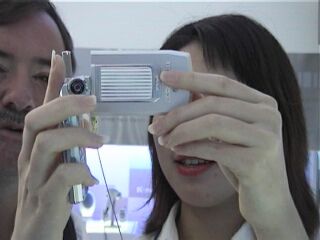
A phone with built-in digital camera
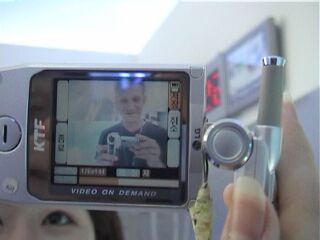
Me on the screen, proving it works
I’m all in favour of gadgets that combine as many different media in to a single device as possible. I love my Sony digital video camera for that reason – it doubles as the stills camera that has provided the pictures for this website, as well as taking remarkable quality video. I’d have liked this swivel-phone even better if it had stored the photos on a remote server rather than on the phone itself, but maybe that’s one for the upgrade.
Mobile Commerce
Two kinds of commercial interactions were on display. First was a drinks machine that you played a little jingle to from your phone. Each jingle was a fixed amount of money, and you could download extra jingles to be added to your phonebill. Seemed ridiculously easy to hack to me, and I predict that this one never makes it out of the R and D labs.
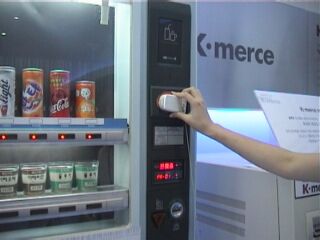
Tunes for drinks
The other interaction was of the ATM flavour, a service that I’m sure gets marketing managers salivating at the thought of being able to tap into those bloated banking sector budgets:
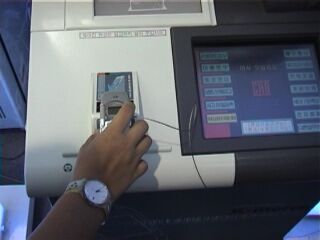
Your mobile phone as cashpoint card
The screen of the phone is passed over a reader in the ATM, allowing the holder to withdraw a certain amount of money. Simple enough, it would seem, but required yet more PIN numbers to download new barcodes for the phone. Can someone please figure out a way of reducing the number of PINs that I have to remember? I even forgot my own mobile phone number today, not having been asked for it for a while. If I have to remember yet another PIN, I’ll scream.
Both of the mobile commerce ideas showed how keen people are to develop such products, but the technical problems I witnessed as the demonstrators struggled to get the things work also reminded me of how fragile such systems are. They look great on the glossy brochure with the colour washed smiling corporate types looking in control of the technology, but real life tends to be a lot more messy.
As for me, if I can just figure out how to access the numbers of the missed calls on my mobile phone, I’ll be a happy chap. I hate not knowing whose calls I’ve missed.
Written by Christian Wach on Saturday, June 15th, 2002

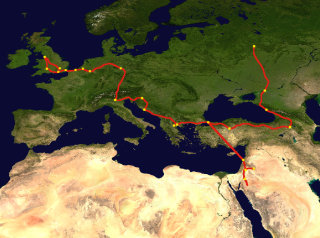
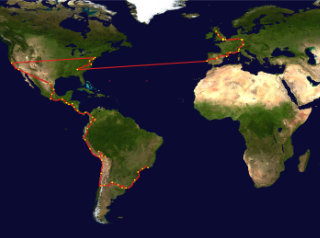
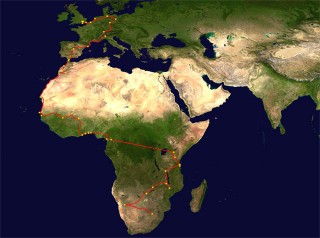
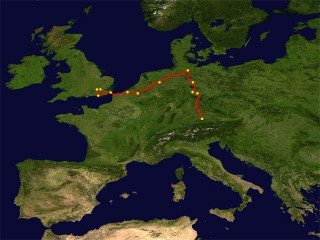
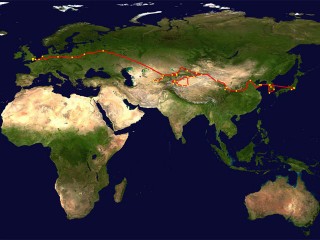





No comments yet
Be the first to leave one!